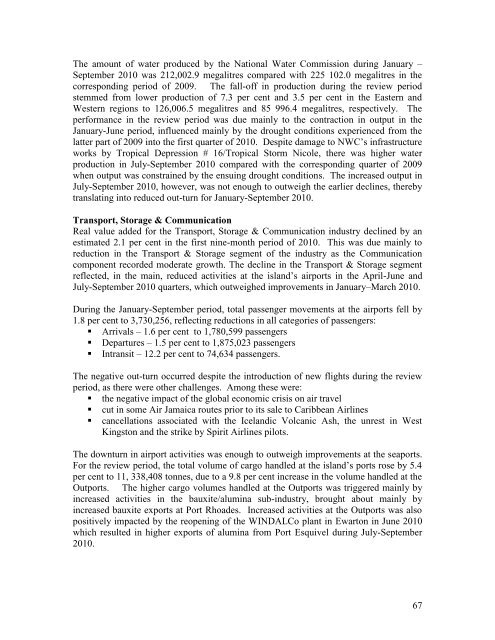PIOJ Growth-Inducement Strategy - Planning Institute of Jamaica
PIOJ Growth-Inducement Strategy - Planning Institute of Jamaica
PIOJ Growth-Inducement Strategy - Planning Institute of Jamaica
You also want an ePaper? Increase the reach of your titles
YUMPU automatically turns print PDFs into web optimized ePapers that Google loves.
The amount <strong>of</strong> water produced by the National Water Commission during January –<br />
September 2010 was 212,002.9 megalitres compared with 225 102.0 megalitres in the<br />
corresponding period <strong>of</strong> 2009. The fall-<strong>of</strong>f in production during the review period<br />
stemmed from lower production <strong>of</strong> 7.3 per cent and 3.5 per cent in the Eastern and<br />
Western regions to 126,006.5 megalitres and 85 996.4 megalitres, respectively. The<br />
performance in the review period was due mainly to the contraction in output in the<br />
January-June period, influenced mainly by the drought conditions experienced from the<br />
latter part <strong>of</strong> 2009 into the first quarter <strong>of</strong> 2010. Despite damage to NWC’s infrastructure<br />
works by Tropical Depression # 16/Tropical Storm Nicole, there was higher water<br />
production in July-September 2010 compared with the corresponding quarter <strong>of</strong> 2009<br />
when output was constrained by the ensuing drought conditions. The increased output in<br />
July-September 2010, however, was not enough to outweigh the earlier declines, thereby<br />
translating into reduced out-turn for January-September 2010.<br />
Transport, Storage & Communication<br />
Real value added for the Transport, Storage & Communication industry declined by an<br />
estimated 2.1 per cent in the first nine-month period <strong>of</strong> 2010. This was due mainly to<br />
reduction in the Transport & Storage segment <strong>of</strong> the industry as the Communication<br />
component recorded moderate growth. The decline in the Transport & Storage segment<br />
reflected, in the main, reduced activities at the island’s airports in the April-June and<br />
July-September 2010 quarters, which outweighed improvements in January–March 2010.<br />
During the January-September period, total passenger movements at the airports fell by<br />
1.8 per cent to 3,730,256, reflecting reductions in all categories <strong>of</strong> passengers:<br />
• Arrivals – 1.6 per cent to 1,780,599 passengers<br />
• Departures – 1.5 per cent to 1,875,023 passengers<br />
• Intransit – 12.2 per cent to 74,634 passengers.<br />
The negative out-turn occurred despite the introduction <strong>of</strong> new flights during the review<br />
period, as there were other challenges. Among these were:<br />
• the negative impact <strong>of</strong> the global economic crisis on air travel<br />
• cut in some Air <strong>Jamaica</strong> routes prior to its sale to Caribbean Airlines<br />
• cancellations associated with the Icelandic Volcanic Ash, the unrest in West<br />
Kingston and the strike by Spirit Airlines pilots.<br />
The downturn in airport activities was enough to outweigh improvements at the seaports.<br />
For the review period, the total volume <strong>of</strong> cargo handled at the island’s ports rose by 5.4<br />
per cent to 11, 338,408 tonnes, due to a 9.8 per cent increase in the volume handled at the<br />
Outports. The higher cargo volumes handled at the Outports was triggered mainly by<br />
increased activities in the bauxite/alumina sub-industry, brought about mainly by<br />
increased bauxite exports at Port Rhoades. Increased activities at the Outports was also<br />
positively impacted by the reopening <strong>of</strong> the WINDALCo plant in Ewarton in June 2010<br />
which resulted in higher exports <strong>of</strong> alumina from Port Esquivel during July-September<br />
2010.<br />
67
















